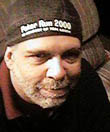|
|
 
|
|
Author
|
Topic: History of the Intermittent
|
|
|
|
|
Tim Reed
Better Projection Pays

Posts: 5246
From: Northampton, PA
Registered: Sep 1999
|
 posted 10-01-2000 05:43 PM
posted 10-01-2000 05:43 PM




This is one of my favorite subjects!Actually, Edison never came up with a workable projector on his own, because he couldn't get the intermittent right. He also thought the idea of projection before a large crowd was silly, when peep show machines, used by a single spectator at a time, could be sold instead. The kinetoscope peep machine had no intermittent, only a rapidly-revolving shutter with a very small opening, spinning before the moving, illuminated filmstrip. Public demand, however, forced Edison to reconsider his stand against projection, and he promised he would invent one. The Vitascope, the first "Edison" projection machine, was in reality Thomas Armat's projector, which featured an intermittent movement (this particular one, I believe, had a beater movement--but his next machine used a geneva movement). Edison bought the machine because he was overdue on his promise to deliver a projector, and he could not come up with one that worked. Armat's interest in selling was in getting the machine mass-produced. As he often did on things he had no part in, Edison took full credit for the invention of the machine. Edison later built his own version of the Vitascope and cut Armat out of the business. Armat then built a geneva machine that ran circles around Edison's projector. Thomas Armat has largely been overlooked by history, save for some old-timer projectionists who know the truth; in favor of crediting the better-known Edison with the creation of motion pictures (in reality, only partially true). The best over all source for the history of motion pictures is Terry Ramsaye's "A Million and One Nights". This was originally a huge two-volume work, first published in the late twenties... before sound. Many of the original pioneers, who were still alive while the book was being written, were personally interviewed by the author, including Edison. It's the standard reference work on motion pictures up to that time, and has been reprinted several times over the years. The book's over 800 pages long! It's long out of print, but you may be able to find a copy at the local public library (or state interlibrary loan program); and certainly, at a university library. Every so often, you'll see a worn out copy on ebay. Be prepared to pay as much as $100 for a fair copy. BTW, the man who designed all of Edison's early motion picture camera equipment (and who wanted to build a projector, too) was William Kennedy Laurie Dickson, an employee of the Edison shop... he was the true inventor of movies, if there ever was one. ------------------
Better Projection Pays!
| IP: Logged
|
|
|
|
|
|
Tim Reed
Better Projection Pays

Posts: 5246
From: Northampton, PA
Registered: Sep 1999
|
 posted 10-01-2000 10:06 PM
posted 10-01-2000 10:06 PM




Matt. Glad I could help, and wonderful to hear you enjoyed the clip! The video is a segment from another video I was working on, so the shots leading up to the animation are a bit out of context.The book is somewhat technical, yes, but probably not to the degree that you want. It is, however, the best source of material that's relatively easy to access. Thomas Armat wrote numerous articles over the years, that delve deeper into the particular issues you mention, but I cannot think of a resource for those at the moment. Maybe old SMPE/SMPTE journals? "A Million and One Nights" is probably your best bet right now, unless someone else has any other suggestions. It's full of intrigue, and would make a good movie on its own. As far as I know, the content of every edition is identical to the original... I didn't know about the 1986 printing.. great! The latest one I knew of was circa 1965. Let us know what you come up with on your project. Good luck!
------------------
Better Projection Pays!
| IP: Logged
|
|
|
|
Tim Reed
Better Projection Pays

Posts: 5246
From: Northampton, PA
Registered: Sep 1999
|
 posted 10-02-2000 07:59 AM
posted 10-02-2000 07:59 AM




Son of a gun, and it's at a low price right now, too! I paid $75 for mine!Go for it. ------------------
Better Projection Pays!
| IP: Logged
|
|
|
|
David Kilderry
Master Film Handler

Posts: 355
From: Melbourne Australia
Registered: Sep 1999
|
 posted 10-03-2000 02:53 AM
posted 10-03-2000 02:53 AM





Matt and Tim,After the intermittant the single biggest invention was the loop! Think about the early projectors and how they operated without a loop - the film just did not last as sprokets were torn by the movement. The development of the loop (along with the upper and lower feed sprokets) was a remarkable development. I think it was invented by General Latham??? David
| IP: Logged
|
|
|
|
|
|
|
|
|
|
|
|
All times are Central (GMT -6:00)
|
|
Powered by Infopop Corporation
UBB.classicTM
6.3.1.2
The Film-Tech Forums are designed for various members related to the cinema industry to express their opinions, viewpoints and testimonials on various products, services and events based upon speculation, personal knowledge and factual information through use, therefore all views represented here allow no liability upon the publishers of this web site and the owners of said views assume no liability for any ill will resulting from these postings. The posts made here are for educational as well as entertainment purposes and as such anyone viewing this portion of the website must accept these views as statements of the author of that opinion
and agrees to release the authors from any and all liability.
|

 Home
Home
 Products
Products
 Store
Store
 Forum
Forum
 Warehouse
Warehouse
 Contact Us
Contact Us




 Printer-friendly view of this topic
Printer-friendly view of this topic















